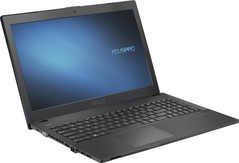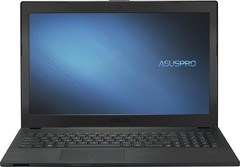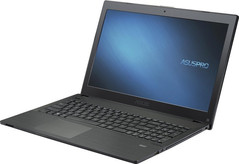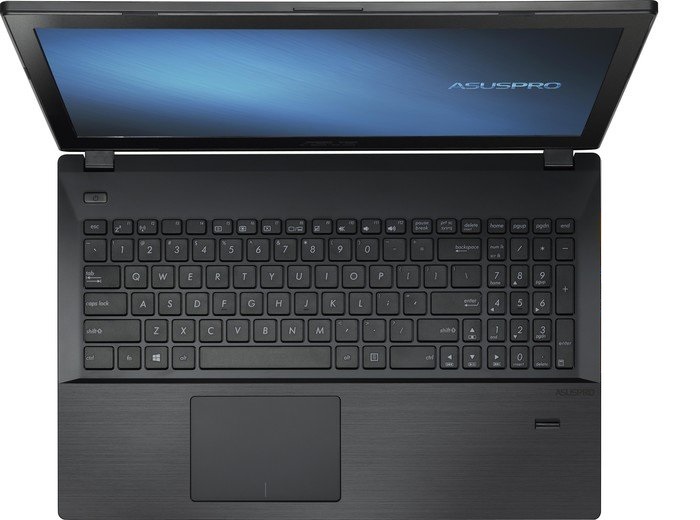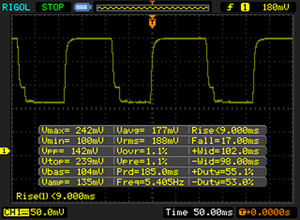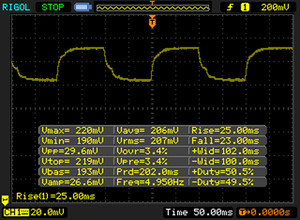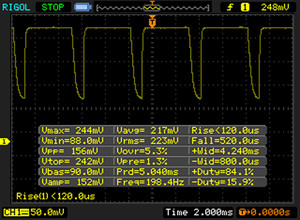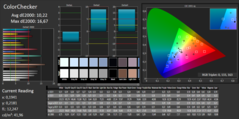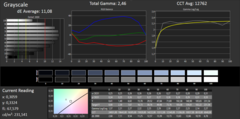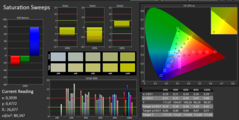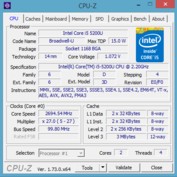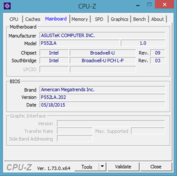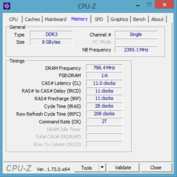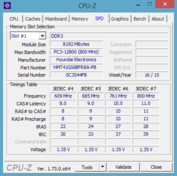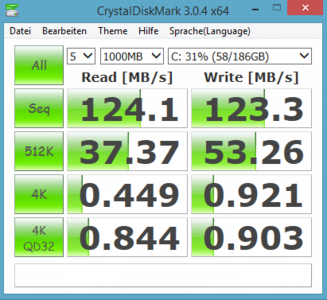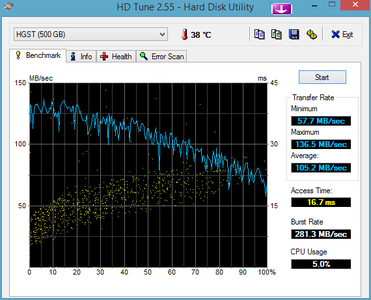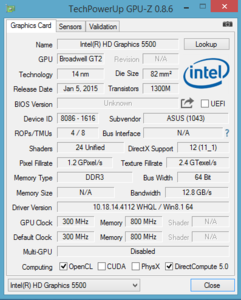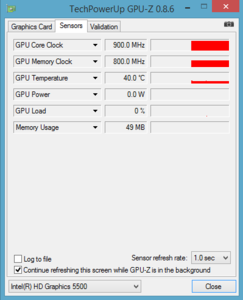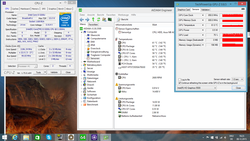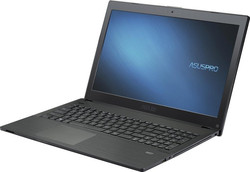Asus ASUSPRO Essential P2520LA-XO0167H Notebook Review
For the original German review, see here.
The 15-inch ASUSPRO Essential P2520LA is a relatively average entry into the world of business notebooks. The ASUSPRO business notebooks are mainly designed for durability and reliability. At the time of testing the price was about 500 Euros (~$543). At its core is an Intel Core i5-5200U of the Broadwell generation with integrated Intel HD Graphics 5500. The matte 15.6-inch display offers a resolution of 1366x768 pixels. For a business solution, Asus has equipped the system richly with 8 GB of DDR3 RAM. A conventional hard drive from HGST with a capacity of 500 GB delivers sufficient storage space. All components are packed into a relatively unremarkable, black plastic case.
The ASUSPRO Essential P2520LA does not lack competitors in the low to mid-priced segment. In our review we will compare it to the following notebooks:
On its home page Asus lists further models of the P2520LA, which differ from our test model in terms of processor, hard drive, display and security features.
Case & Connectivity
The ASUSPRO Essential P2520LA comes in a simple plastic case. ASUS speaks of a "brushed-hairline" look - a plastic imitation which resembles brushed aluminum. Only a chrome-colored "ASUS" logo decorates the otherwise completely black notebook. What attracts negative attention is that fingerprints are clearly visible on the case. A maintenance hatch is missing. If you want to clean the fan or upgrade the system, you have to remove the entire underside. Our test model has a free RAM slot for upgrading the RAM. Overall, the build quality of the ASUSPRO is good.
Asus delivers the usual interfaces. Out of a total of four USB ports, three are USB 3.0 ports and one USB 2.0 port. This is perfectly alright. Gigabit LAN, Wi-Fi and Bluetooth 4.0 are also on board and provide sufficient connectivity.
Input Devices
Asus offers the notebook with an unlit keyboard. The keys are slightly roughened and offer a good pressure point. The palm rest and the keyboard part are made from a single piece. As a result, the keyboard hardly yields when typing. The keys are decently sized and are all on one level. The number pad keys are slightly smaller than the rest. The touchpad with a size of 10.5 x 7.3 cm (~4.1 x 2.9 in) works impeccably and is on a level with the palm rest. Fingers glide easily across the smooth surface. Since there are no dedicated mouse buttons, the whole surface of the input device can be used to position the mouse cursor. Moreover, the touchpad supports multi touch gestures like scrolling or pinch to zoom.
Display
The matte 15.6-inch display of the ASUSPRO P2520LA features a native WXGA resolution of 1366x768 pixels. This gives a pixel density of 100 PPI. In terms of brightness, the display does not perform great. With an average brightness of 219.7 cd/m² in mains operation and 184 cd/m² on battery, you can only work comfortably when connected to the power grid.
Moreover, a uniform brightness distribution is important and 85% is a relatively good value. Most of our test devices achieve 80% or higher.
| |||||||||||||||||||||||||
Brightness Distribution: 85 %
Center on Battery: 184 cd/m²
Contrast: 543:1 (Black: 0.42 cd/m²)
ΔE ColorChecker Calman: 10.22 | ∀{0.5-29.43 Ø4.78}
ΔE Greyscale Calman: 11.08 | ∀{0.09-98 Ø5}
58% sRGB (Argyll 1.6.3 3D)
37% AdobeRGB 1998 (Argyll 1.6.3 3D)
39.84% AdobeRGB 1998 (Argyll 3D)
57.8% sRGB (Argyll 3D)
38.55% Display P3 (Argyll 3D)
Gamma: 2.46
CCT: 12762 K
| Asus ASUSPRO Essential P2520LA-XO0167H HD Graphics 5500, 5200U, Hitachi Travelstar Z7K500 HTS725050A7E630 | HP 350 G2 L8B05ES Radeon R5 M240, 5200U, Seagate Momentus ST750LM022 HN-M750MB | Lenovo IdeaPad 305-15IBD Radeon R5 M330, 5200U, Seagate Momentus SpinPoint M8 ST1000LM024 | Dell Vostro 3558 HD Graphics 5500, 5200U, Western Digital Scorpio Blue WD5000LPVX | HP 15-r220ng HD Graphics 5500, 5200U, Western Digital Scorpio Blue WD5000LPVX | |
|---|---|---|---|---|---|
| Display | 13% | 7% | 4% | -11% | |
| Display P3 Coverage (%) | 38.55 | 43.59 13% | 41.15 7% | 40.25 4% | 34.13 -11% |
| sRGB Coverage (%) | 57.8 | 64.8 12% | 61.9 7% | 60.6 5% | 51.4 -11% |
| AdobeRGB 1998 Coverage (%) | 39.84 | 45.06 13% | 42.52 7% | 41.59 4% | 35.26 -11% |
| Response Times | -1% | ||||
| Response Time Grey 50% / Grey 80% * (ms) | 48 ? | 49 ? -2% | |||
| Response Time Black / White * (ms) | 26 ? | 26 ? -0% | |||
| PWM Frequency (Hz) | 198 ? | ||||
| Screen | 5% | -4% | -18% | -14% | |
| Brightness middle (cd/m²) | 228 | 251 10% | 214 -6% | 267 17% | 253 11% |
| Brightness (cd/m²) | 220 | 231 5% | 228 4% | 253 15% | 240 9% |
| Brightness Distribution (%) | 85 | 86 1% | 84 -1% | 91 7% | 87 2% |
| Black Level * (cd/m²) | 0.42 | 0.53 -26% | 0.42 -0% | 0.78 -86% | 0.52 -24% |
| Contrast (:1) | 543 | 474 -13% | 510 -6% | 342 -37% | 487 -10% |
| Colorchecker dE 2000 * | 10.22 | 7.92 23% | 12.18 -19% | 14.62 -43% | 15.56 -52% |
| Greyscale dE 2000 * | 11.08 | 8.9 20% | 13.53 -22% | 16.03 -45% | 15.09 -36% |
| Gamma | 2.46 89% | 2.18 101% | 2.26 97% | 2.36 93% | 2.46 89% |
| CCT | 12762 51% | 9917 66% | 15817 41% | 23192 28% | 19263 34% |
| Color Space (Percent of AdobeRGB 1998) (%) | 37 | 41 11% | 39 5% | 39 5% | 33 -11% |
| Color Space (Percent of sRGB) (%) | 58 | 65 12% | 62 7% | 61 5% | |
| Colorchecker dE 2000 max. * | 24.75 | ||||
| Total Average (Program / Settings) | 9% /
7% | 1% /
-1% | -7% /
-12% | -13% /
-13% |
* ... smaller is better
Display Response Times
| ↔ Response Time Black to White | ||
|---|---|---|
| 26 ms ... rise ↗ and fall ↘ combined | ↗ 9 ms rise | |
| ↘ 17 ms fall | ||
| The screen shows relatively slow response rates in our tests and may be too slow for gamers. In comparison, all tested devices range from 0.1 (minimum) to 240 (maximum) ms. » 61 % of all devices are better. This means that the measured response time is worse than the average of all tested devices (20.2 ms). | ||
| ↔ Response Time 50% Grey to 80% Grey | ||
| 48 ms ... rise ↗ and fall ↘ combined | ↗ 25 ms rise | |
| ↘ 23 ms fall | ||
| The screen shows slow response rates in our tests and will be unsatisfactory for gamers. In comparison, all tested devices range from 0.165 (minimum) to 636 (maximum) ms. » 82 % of all devices are better. This means that the measured response time is worse than the average of all tested devices (31.6 ms). | ||
Screen Flickering / PWM (Pulse-Width Modulation)
| Screen flickering / PWM detected | 198 Hz | ≤ 90 % brightness setting | |
The display backlight flickers at 198 Hz (worst case, e.g., utilizing PWM) Flickering detected at a brightness setting of 90 % and below. There should be no flickering or PWM above this brightness setting. The frequency of 198 Hz is relatively low, so sensitive users will likely notice flickering and experience eyestrain at the stated brightness setting and below. In comparison: 53 % of all tested devices do not use PWM to dim the display. If PWM was detected, an average of 8108 (minimum: 5 - maximum: 343500) Hz was measured. | |||
The integrated TN panel is not impressive in terms of color fidelity. Our test software CalMan - Color Checker shows a DeltaE 2000 deviation of 10.22 out-of-the-box. This is noticeable in the blue tint, which is almost typical of TN panels. We are used to values between 10 and 12 in this segment. A value less than 3 would be ideal. In addition, the display of the ASUSPRO is very viewing-angle-dependent.
Performance
The ASUSPRO P2520LA is a simple 15-inch office notebook. Powered by an Intel Core i5-5200U, it delivers sufficient performance for office, Internet and multimedia applications. Asus also offers this notebook with an Intel Core i3 or an Intel Core i7 of the 5th generation. The conventional HDD from HGST delivers sufficient performance with a capacity of 500 GB. An SSD would have been the better choice for mobility because of its shock resistance.
Processor
Our test model uses an Intel Core i5-5200U from Intel. With two physical cores and Hyperthreading technology, it delivers sufficient performance to enable fast working. Even demanding software and multitasking apps do not pose a problem. The base clock is 2.2 GHz and the clock rate can increase to up to 2.7 GHz in Turbo mode. The benchmark results are all on a level with the devices in our comparison, which also use an Intel Core i5-5200U. The ASUSPRO P2520LA performs significantly better than the Lenovo IdeaPad 305-15 with AMD A6-6310.
System Performance
The system works smoothly and its performance conforms to the expectations on its Broadwell platform. All test models with Intel Core i5-5200U are on par. Only the HP 350 G2 L8B05ES performs slightly better, since it comes with a dedicated Radeon R5 M240 GPU. The use of an SSD could increase the system performance.
| PCMark 7 Score | 2807 points | |
| PCMark 8 Home Score Accelerated v2 | 2835 points | |
| PCMark 8 Creative Score Accelerated v2 | 3146 points | |
| PCMark 8 Work Score Accelerated v2 | 2707 points | |
Help | ||
Storage Devices
The system drive is a conventional one from HGST. Its storage capacity is 500 GB and works at a rotation speed of 7200 RPM. HD Tune reports an average transfer rate of 105.2 MB/s. The HDD achieves a read rate of 124.1 MB/s in CrystalDiskMark. These results are normal for an HDD with 7200 RPM.
Graphics Card
The ASUSPRO P2520LA uses the Intel HD Graphics 5500 as its graphics solution. The GPU is integrated in the Broadwell processor and supports OpenCL 2.0 as well as DirectX 12 (FL 11_1). The performance is not surprising and on the expected level. The clock rate of the GPU reaches 900 MHz. By adding a second RAM module (dual channel mode), the performance can be increased by up to 20%. However, users with higher performance requirements had better consider a solution with a dedicated GPU. The HP 350 G2 L8B05ES with dedicated AMD Radeon R5 M240 performs significantly better than the Intel HD Graphics 5500.
| 3DMark 11 - 1280x720 Performance GPU (sort by value) | |
| Asus ASUSPRO Essential P2520LA-XO0167H | |
| Lenovo IdeaPad 100-15IBY | |
| Lenovo IdeaPad 305-15ABM | |
| HP 350 G2 L8B05ES | |
| Dell Vostro 3558 | |
| HP 15-r220ng | |
| 3DMark | |
| 1280x720 Ice Storm Standard Graphics (sort by value) | |
| Asus ASUSPRO Essential P2520LA-XO0167H | |
| Lenovo IdeaPad 100-15IBY | |
| Lenovo IdeaPad 305-15ABM | |
| HP 350 G2 L8B05ES | |
| Dell Vostro 3558 | |
| HP 15-r220ng | |
| 1280x720 Cloud Gate Standard Graphics (sort by value) | |
| Asus ASUSPRO Essential P2520LA-XO0167H | |
| Lenovo IdeaPad 100-15IBY | |
| Lenovo IdeaPad 305-15ABM | |
| HP 350 G2 L8B05ES | |
| Dell Vostro 3558 | |
| HP 15-r220ng | |
| 3DMark 06 Standard Score | 6839 points | |
| 3DMark Vantage P Result | 3957 points | |
| 3DMark 11 Performance | 901 points | |
| 3DMark Ice Storm Standard Score | 40196 points | |
| 3DMark Cloud Gate Standard Score | 3639 points | |
| 3DMark Fire Strike Score | 500 points | |
| 3DMark Fire Strike Extreme Score | 224 points | |
Help | ||
Gaming Performance
The ASUSPRO P2520LA is a classic office notebook without a dedicated GPU. Thus, only very undemanding games can run with acceptable frame rates. “Tomb Raider” or “Dirt Rally” can run smoothly at low resolutions and with minimum quality settings. The Asus does not achieve playable frame rates in performance hungry games such as “Thief”.
| Asus ASUSPRO Essential P2520LA-XO0167H HD Graphics 5500, 5200U, Hitachi Travelstar Z7K500 HTS725050A7E630 | Lenovo IdeaPad 100-15IBY HD Graphics (Bay Trail), N3540, Seagate Momentus Thin ST500LT012-1DG142 | Lenovo IdeaPad 305-15ABM Radeon R4 (Beema), A6-6310, Seagate Momentus Thin ST500LT012-1DG142 | HP 350 G2 L8B05ES Radeon R5 M240, 5200U, Seagate Momentus ST750LM022 HN-M750MB | Dell Vostro 3558 HD Graphics 5500, 5200U, Western Digital Scorpio Blue WD5000LPVX | HP 15-r220ng HD Graphics 5500, 5200U, Western Digital Scorpio Blue WD5000LPVX | |
|---|---|---|---|---|---|---|
| Tomb Raider | -67% | -19% | 48% | -6% | -1% | |
| 1024x768 Low Preset (fps) | 41.5 | 14 -66% | 33.1 -20% | 62.8 51% | 39.2 -6% | 41.5 0% |
| 1366x768 Normal Preset AA:FX AF:4x (fps) | 21.8 | 7.1 -67% | 17.8 -18% | 31.6 45% | 20.8 -5% | 21.4 -2% |
| Dirt Rally | -46% | -16% | 83% | -9% | ||
| 1024x768 Ultra Low Preset (fps) | 66.1 | 24.2 -63% | 52.3 -21% | 122.7 86% | 58.1 -12% | |
| 1366x768 Medium Preset (fps) | 17.27 | 12.5 -28% | 15.6 -10% | 31.1 80% | 16.3 -6% | |
| Total Average (Program / Settings) | -57% /
-56% | -18% /
-17% | 66% /
66% | -8% /
-7% | -1% /
-1% |
| low | med. | high | ultra | |
|---|---|---|---|---|
| Tomb Raider (2013) | 41.5 | 21.8 | 14.2 | |
| Thief (2014) | 13.7 | 9 | 7.3 | |
| Dirt Rally (2015) | 66.1 | 17.27 |
Emissions & Energy
System Noise
During everyday use, the active cooler is hardly audible. However, the noise of the read and write heads of the hard drive is permanently present. An SSD would help here. However, with 33.4 dB(A) it should not be too disturbing. The noise reaches a maximum of 38.6 dB(A) when the optical drive is used.
Noise level
| Idle |
| 33 / 33 / 33 dB(A) |
| HDD |
| 33.4 dB(A) |
| DVD |
| 38.6 / dB(A) |
| Load |
| 34 / 34 dB(A) |
 | ||
30 dB silent 40 dB(A) audible 50 dB(A) loud |
||
min: | ||
Temperature
During the stress test (Prime95 and FurMark run simultaneously for at least one hour) the processor clocks at 2.2 GHz in mains operation. In battery mode, the CPU clock rate falls to 1.6 to 1.7 GHz. The graphics unit clocks at 750 to 850 MHz in mains operation as well as on battery. Under full load, the notebook does not get excessively warm. Only in a single segment, the fan outlet, the temperature comes close to 42 degrees Celsius (~108 degrees Fahrenheit). All other readings are significantly below 40 degrees Celsius (~104 degrees Fahrenheit).
(±) The maximum temperature on the upper side is 41.9 °C / 107 F, compared to the average of 34.3 °C / 94 F, ranging from 21.2 to 62.5 °C for the class Office.
(+) The bottom heats up to a maximum of 37.1 °C / 99 F, compared to the average of 36.8 °C / 98 F
(+) In idle usage, the average temperature for the upper side is 25.6 °C / 78 F, compared to the device average of 29.5 °C / 85 F.
(±) The palmrests and touchpad can get very hot to the touch with a maximum of 37.5 °C / 99.5 F.
(-) The average temperature of the palmrest area of similar devices was 27.6 °C / 81.7 F (-9.9 °C / -17.8 F).
Speakers
The two speakers sit under the palm rest relatively far to the right and left. The sound, which is emitted towards the table, is not particularly good. It does not make much difference when the two small grilles are covered. The volume is decent for an office notebook. The sound does not scratch or distort at maximum volume.
Power Consumption
The ASUSPRO requires up to 0.6 watts in standby mode, which is too much. Competitors like the Dell Vostro 15 3558 perform better. While idling, the test model makes do with a maximum of 7.4 watts. During the stress test, a maximum of 28.4 watts is reached, which is also due to CPU and GPU throttling. If CPU and GPU did not throttle, the energy demand would be higher. The power adapter is rated at 65 watts.
| Off / Standby | |
| Idle | |
| Load |
|
Key:
min: | |
Battery Life
Our realistic Wi-Fi test automatically opens web site at 40 second intervals. The profile "balanced" is active and the display brightness is set to about 150 cd/m². The ASUSPRO P2520LA achieves a decent battery life of 5:21 hours.
Pros
Cons
Verdict
The ASUSPRO Essential P2520LA under review is a 15.6 inch office notebook with a few multimedia properties. The integrated Broadwell CPU offers more than sufficient performance for everyday office use. The computer works quietly and coolly during everyday use. The case appears solid, but cannot stand out from the competition due to its simplicity. The incorporated hard drive features a capacity of 500 GB and rotates at 7200 RPM. If you want to do without the noise of a conventional hard drive, you can replace it with a significantly faster solid-state disk. However, you have to remove the underside of the notebook completely in order to do so since a maintenance hatch is unfortunately missing. Both keyboard and touchpad left a good impression. However, we would wish for a subtle keyboard light. Buyers should not expect too much from the ASUSPRO's display. ASUS offers a two-year warranty.
Anyone looking for a new office notebook for occasional work may opt for the ASUSPRO Essential P2520LA. However, prospective buyers have to accept its low display quality. With a price tag of 545 Euros (~$592) the notebook is not really a bargain. However, it has to be mentioned, that it offers a powerful CPU and a large RAM capacity of 8 GB. In addition, our test model includes a Windows 8.1 license with a free upgrade to Windows 10.
Asus ASUSPRO Essential P2520LA-XO0167H
- 02/25/2016 v5 (old)
Sebastian Bade





